Multi-angle Color & Effect
BYK-mac i
Product InfoEffect of Raw Materials on Color & Gloss
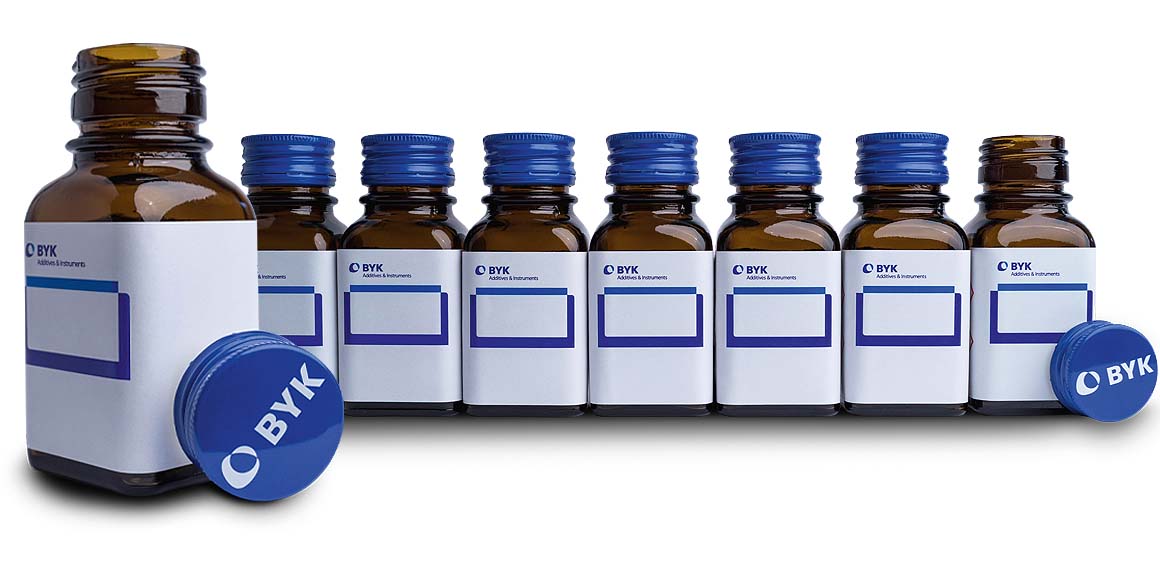
"The first step is always the hardest." This also applies when formulating a coating. The application of the final finish determines the selection of the raw materials. Not only are mechanical properties like abrasion resistance and adhesion important, but also optical attributes like color, gloss and opacity; and one cannot forget the overall costs of the formulation. In order to guarantee consistent quality a routine quality control system needs to be established at the very first production step.
Paint is a liquid or powdery coating that is applied on objects as a very thin layer. By means of chemical or physical processes, it converts to an adherent film. Paint normally consists of the following components:
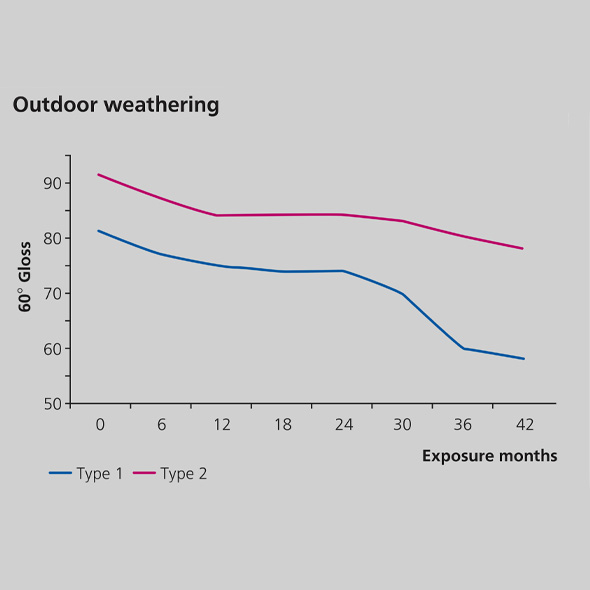
The binder or resin combines all solid components of the coating and acts as the film former. It imparts mechanical properties such as hardness, flexibility and adhesion. The binder itself is clear and glossy.
Resin systems are subject to degradation by thermal and photo induced oxidation. Therefore, resistance against weathering and UV radiation needs to be ensured. This is highly important for corrosion coatings that protect objects like bridges, storage tanks or steel structures against environmental influences. Tests are either done by using accelerating weathering chambers or under real-world conditions. The most popular weathering areas are located in Arizona and South Florida.
In this example, two different types of silicone-epoxy resins were exposed. As displayed in the graph, type 2 started at a higher initial 60° gloss and even after 42 months of Florida exposure continues to maintain a much higher gloss level than type 1.
Color retention was excellent for both systems. After 42 months of outside exposure they exhibit a ΔE* of less than 1 compared to the control.
Fillers are solid particles, which are virtually insoluble in the vehicle. They serve to increase the volume of the paint and to improve mechanical and optical properties. They are usually less expensive than other pigments and reduce the overall costs of a paint formulation. Among all, calcium carbonate fillers are quantitatively the most important class. They exhibit a neutral tone and a high brightness (L* ≥ 95) and can therefore be used to substitute TiO2. As their mean particle size is larger and their refractive index is lower, care has to be taken to achieve the required hiding power. New synthetically produced calcium carbonate types are available which consider the aforementioned. In a medium class interior paint formulation with 12.5 % TiO2 and a PVC (pigment volume concentration) of 76 % the amount of TiO2 was substituted 1:1 by the new calcium carbonate type. This graph shows the results: Opacity as well as brightness compared to the standard formulation did not change up to a TiO2 substitution of 60 %.1)
In this experiment only an increase in 85° gloss from 4 to 7 gloss units was monitored.
1) Dr. Petra Fritzen; Solvay Chemicals GmbH: Ein gut gefülltes Paket; Farbe und Lack (June 2015); page 58 – 62
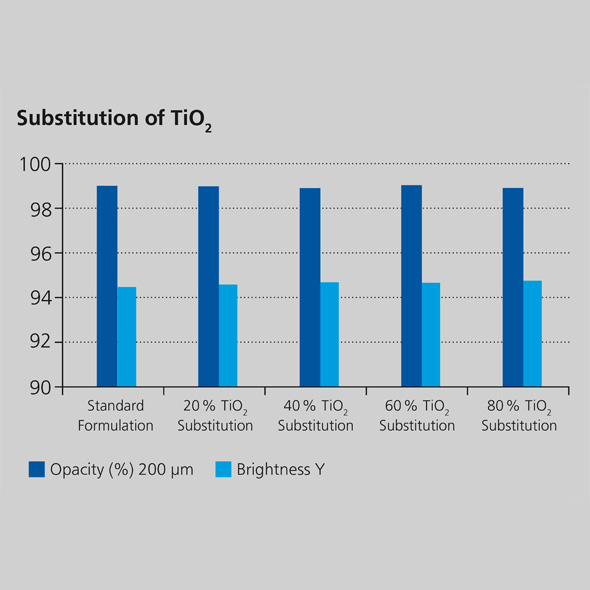
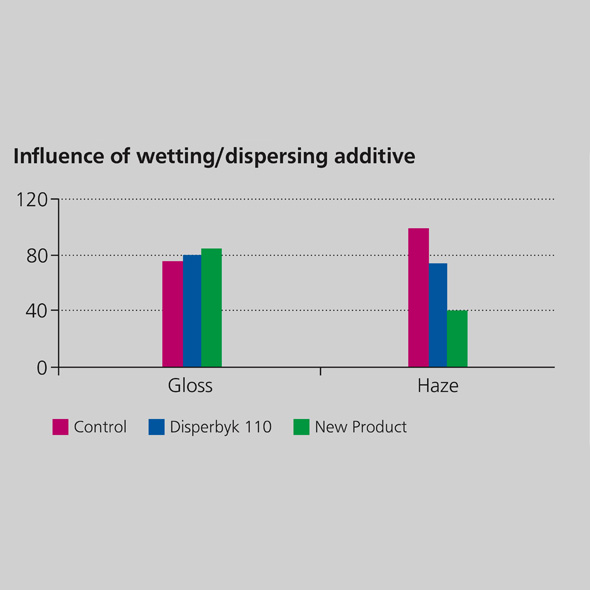
Additives are substances that are added to a coating in very small amounts to improve properties such as wetting and dispersing, flow and leveling, defoaming or can act as matting agent.
One of the most important steps in the production of pigmented coatings is the homogeneous distribution and stabilization of pigments and fillers within the liquid binder solution. If this step is not optimized, a variety of defects can occur: e.g. flocculation, gloss reduction, color shift and settling. Wetting and dispersing additives are surface-active substances that improve the wetting of solids and prevent the flocculation of the particles. The diagram shows the influence of wetting/ dispersing additives on the dispersion quality. Two different additives used in a solvent-free coating system are compared with the same system without additive (= control). The new product perfectly stabilizes the pigments resulting in an increased 20° gloss value and a significant reduction in haze.
The chapter “Industrial coatings” discusses an application how the orange peel of powder coatings can be optimized by using the flow & levelling additive BYK-3902 P. Measurements were taken using the wave-scan instrument.
Dependent on their particle size, wax additives can have an influence on the surface gloss. Usually, particle sizes larger than 1 μm produce a matting effect. CERAFLOUR 1000 is a micronized polymer with wax-like properties to improve surface protection and haptics (soft feel effect). It has a matting effect, especially in radiation curable systems. The graph shows the influence of additive concentration on the gloss level of a 1-K AC-PU Copolymer Dispersion. Even after 4 week storage at 40°C the matting effect isn`t hardly reduced.
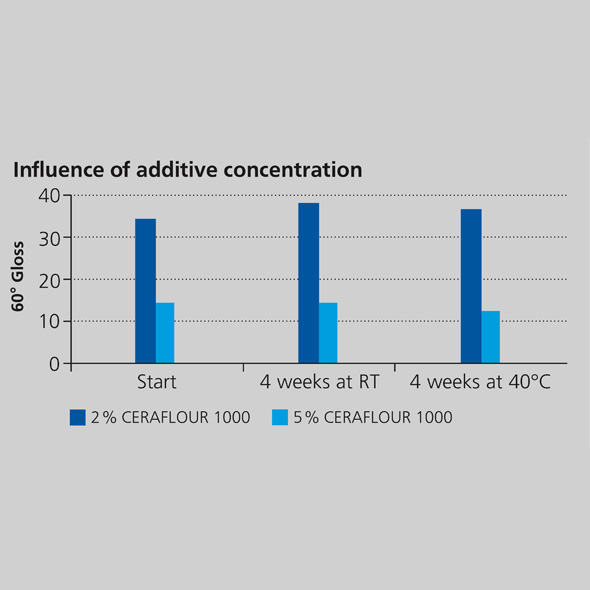
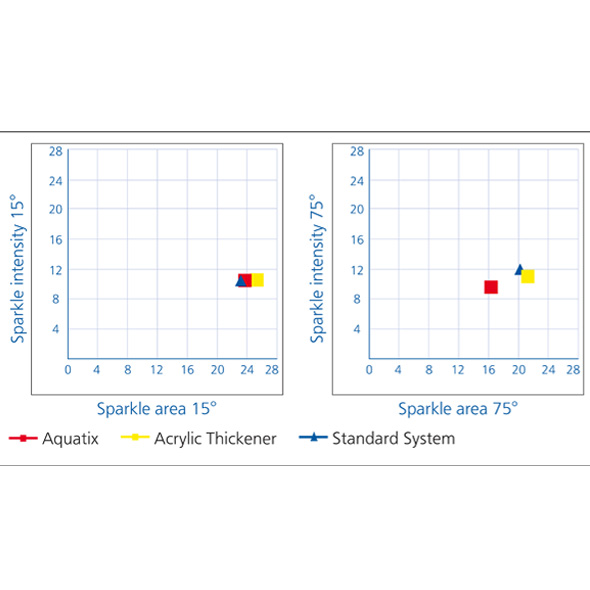
Rheology additives are used to adjust the flow behavior of the coating. For example waxes are utilized to improve the orientation of effect pigments. In the following example a waterborne system was evaluated using three different rheology additives: a standard system, an acrylic thickener and the wax additive AQUATIX®. Visually, the three panels look the same under direct illumination at a steep angle. When comparing at a lower grazing angle, the system using the wax additive shows less sparkling.
BYK-mac i measurement data correlate with a visual judgment. The sparkle area for the system with wax additive at 75° is smaller than for the two other systems. As Sparkle 75° evaluates flakes which are non-parallel oriented, this clearly shows that by using the wax additive AQUATIX® the orientation of the aluminum flakes is improved.